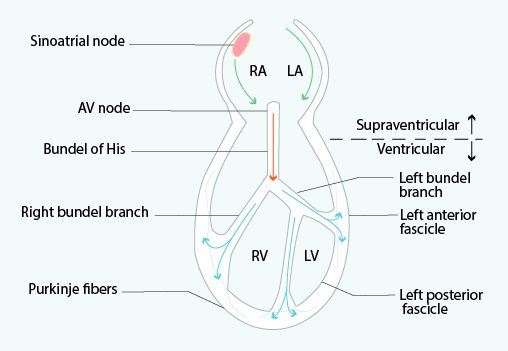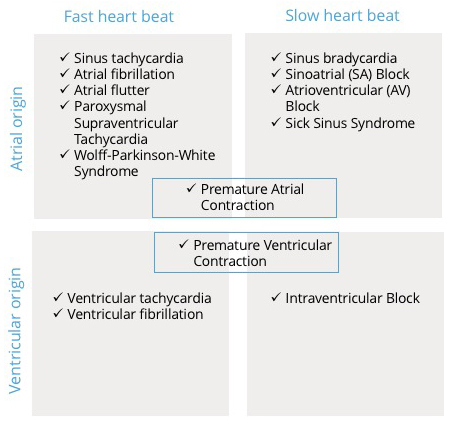Heart Rhythm Disorders (Arrhythmias)
Almost everyone will be affected by an arrhythmia at some point in his life. With a heart rhythm disorder, the heart beats too fast (tachycardia), too slow (bradycardia) or irregularly. In many cases, harmless extra beats are present which manifest as palpitations. These typically do not require treatment, but they should not be ignored as they can lead to other events and long-term effects. On the other hand, some arrhythmias have more serious consequences and therefore need to be diagnosed and treated immediately.
What is the heart’s normal rhythm?
How are arrhythmias classified?
What are some symptoms of arrhythmias?
How are arrhythmias diagnosed?
What is the heart’s normal rhythm?
The heart normally beats in a constant, regular rhythm. The conduction system of the heart allows electrical impulses generated from the sinus node to follow their regular pathway through the atria, over the AV node and to the ventricles (see Figure 1).

This electrical conduction creates the regular contraction and relaxation of the heart. When this process occurs as planned and without interruptions, this is known as a sinus rhythm. A normal heart rate for adults is between 50 and 100 beats per minute, dependent upon age and physical fitness.
How do arrhythmias arise?
An arrhythmia arises when the normal pathway of the heart’s electrical impulse is disrupted. This can be due to failure of the sinus node to create the electrical impulse, improper transmission of the impulse, or creation of additional pathologic impulses outside of the sinus node (e.g. in the atria or ventricles).
There are many reasons why the above can happen—some of which are congenital (present at birth), and others which are acquired (developed after birth). A few common causes of the latter include: heart attack (current or prior), heart failure, thyroid disorders, heart muscle inflammation, high blood pressure and cardiomyopathy. Arrhythmias also affect individuals with healthy hearts—they can be triggered by things such as: smoking, electrolyte disturbances, caffeine or stress.

How are arrhythmias classified?
Arrhythmias are typically classified according to both their associated heart rate and their location of origin.
A rapid heart beat (>100 beats per minute) is known as tachycardia and a slow heart beat (<50-60 beats per minute) is known as bradycardia. A heart beat originating in the upper chambers (atria) of the heart is referred to either as an atrial or supraventricular arrhythmia; a heart beat originating in the lower chambers (ventricles) of the heart is referred to as a ventricular arrhythmia.
Some common arrhythmias are shown in the table below.
What are some symptoms of arrhythmias?
The symptoms of arrhythmias are varied. Some arrhythmias do not cause any symptoms at all, and therefore remain undiagnosed or are only diagnosed incidentally. When symptoms are present, a plethora of symptoms may be present; these include: fainting, dizziness, lightheadedness, shortness of breath, palpitations, chest pain, anxiety, fatigue, or weakness. The symptoms often do not indicate the exact diagnosis, and a diagnosis is therefore critical to determine if treatment is required or not.
How are arrhythmias diagnosed?
In order to diagnose an arrhythmia, a detailed medical history and physical examination are performed in addition to various tests to monitor the heart. The initial test is typically a 12-lead electrocardiogram (ECG). This is a short, non-invasive test that serves various functions in the diagnosis and evaluation of an arrhythmia. It can provide valuable clues as to the cause of the arrhythmia, such as identifying evidence of cardiomyopathy or a prior heart attack. It can also provide insight into the location of the heart that is triggering the disturbance. However, not all arrhythmias can be detected on an ECG given the short test duration. In this situation, a Holter or event monitor may be used allow for an ECG to be recorded over a longer period of time. Additionally, an echocardiogram (ultrasound evaluation) is often performed to evaluate the size, walls, valves, and movement of the heart.
The diagnosis of arrhythmias is not always easy given their often-intermittent presence, but a combination of the above tests is usually the first step towards establishing a diagnosis.